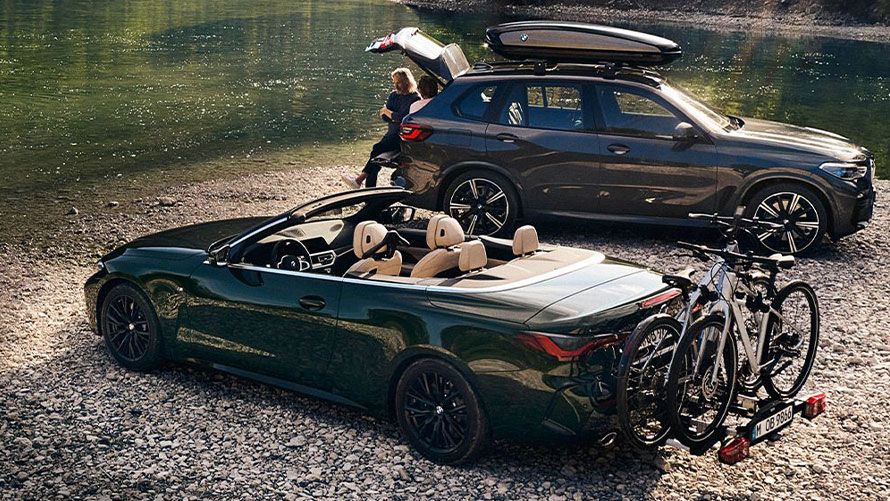Our tool for managing your permission to our use of cookies is temporarily offline. Therefore some functionality is missing.
THE LATEST BMW 1 SERIES.
BMW 1 SERIES OVERVIEW.
The BMW 1 series proves how technical innovations, a stylish appearance, and precise driving dynamics have placed BMW at the pinnacle of the compact class. The vehicle combines supremely efficient design with powerful, economical engines. The quasi-successor of the BMW 3 Series Compact (E36, E46) combines modern, advanced technology and performance with high-end features such as a sophisticated driving assistance systems and superior comfort in its class.
5 CHARACTERISTICS OF THE BMW 1 SERIES.
- 01 Exceptional driving dynamics and agility
- 02 Stylish, sporty design
- 03 Efficient, high-performance engines
- 04 A choice of individual equipment options
- 05 An excellent connection to all services thanks to BMW ConnectedDrive

A BRIEF HISTORY OF THE BMW 1 SERIES.
Find out more about the history and evolution of the BMW 1, the series that marks BMW’s entry into the compact class. Discover the reasons why the BMW 1 series sets the standards in its class.
A BRIEF HISTORY OF THE BMW 1 SERIES.
Find out more about the history and evolution of the BMW 1, the series that marks BMW’s entry into the compact class. Discover the reasons why the BMW 1 series sets the standards in its class.
THE FIRST GENERATION BMW 1 SERIES.

(BMW E81, E82, E87, E88)
When the BMW 1 series launches in 2004, the compact class car immediately becomes the front runner in so many respects. The vehicle boasts the typical characteristics of a BMW such as driving pleasure, high-quality engines, and precise driving dynamics, plus the option to add high-end features such as an iDrive system.
But the BMW 1 series sets the bar even higher. It has the longest wheelbase in its class, with short front and rear overhangs and is the first vehicle in its segment to feature a two-stage brake light. It stands out thanks to a particularly harmonious combination of sporty driving characteristics and long-distance traveling comfort. Agility and steering precision make driving a real pleasure – not only on winding country roads but also in the city.
In 2007, the BMW 1 series is given a facelift with light rings as daytime running lights, an even more dynamic front and rear design and EfficientDynamics, which includes an automatic start/stop function. At the end of 2007, the BMW 1 Series Coupé is launched, followed shortly afterwards by the BMW 1 Series Convertible. They continue to be built until the end of 2013, when they are replaced by the BMW 2 series in 2014.
Production period: 2004–2013
Engines: 1.6–3.0 liters (85–250 kW, 116–340 hp), 4- & 6-cylinder
Length/width/height: 4,227–4,380 mm/1,748–1,803 mm/1,411–1,430 mm
THE SECOND GENERATION BMW 1 SERIES.

(BMW F20, F21)
In 2011, the new edition of the BMW 1 series brings a breath of fresh air to the compact car segment. The lines of the extended side sills emphasize the dynamic, stretched silhouette and the powerful contouring of the side walls highlights the rear wheel arches. Harmonious weight distribution and high-quality suspension technology facilitate sporty driving dynamics and precise control.
Inside, everything is designed for driving pleasure. From the various fittings to the quality of workmanship typical of BMW. The various driving assistance systems available include a parking assistant, reversing camera and adaptive cornering lights.
In 2012 the top-of-the-range automobile arrives at dealerships: the BMW M135i. With a power output of 235 kW (320 hp) it grabs the headlines with the balance of drive and chassis technology typical of the M models.
In 2015, the front and rear of the model are redesigned and now look even more impressive. The engines shine with more power, lower fuel consumption and fewer exhaust emissions.
Production period: 2011–2019
Engines: 1.5–3.0 liters (75–250 kW, 102–544 hp), 3-, 4- & 6-cylinder
Length/width/height: 4,324–4,329 mm/1,765 mm/1,421–1,440 mm
THE THIRD GENERATION BMW 1 SERIES.

(BMW F40)
The BMW 1 series model available from 2019 onwards takes the ideas behind the series to new heights. Starting with its progressive styling, modern silhouette and striking front which gives the vehicle clear supremacy in its class. The sharply-drawn lines lead from the dynamic large double kidney to the athletic tail.
The agile and efficient engines and the sporty suspension, optionally adaptive by adjusting the damping characteristics, guarantee sporty driving dynamics. And finally there is the Steptronic Sport transmission with eight gears available for the BMW 1 series.
As expected from a BMW, the cockpit focuses on the driver. Passengers enjoy the strikingly appealing ambiance of the interior. The driving assistance systems now include optional front collision warning with automatic braking, as well as parking and reversing assistants for even greater safety.
The engines are optimized again at the end of 2020. A 4-cylinder engine with 2-liter displacement is now available, with 131 kW (178 hp) for the BMW 120i and 195 kW (265 hp) for the BMW 128ti.
Production period: 2019–today
Engines: 1.5–2.0 liters (80–225 kW, 109–306 hp), 3- & 4-cylinder
Length/width/height: 4,319 mm/1,799 mm/1,434 mm
Fuel consumption and CO2 emissions.
The values of fuel consumptions, CO2 emissions and energy consumptions shown were determined according to the European Regulation (EC) 715/2007 in the version applicable at the time of type approval. The figures refer to a vehicle with basic configuration in Germany and the range shown considers optional equipment and the different size of wheels and tires available on the selected model.
The CO2 efficiency specifications are determined according to Directive 1999/94/EC and the European Regulation in its current version applicable. The values shown are based on the fuel consumption, CO2 values and energy consumptions according to the NEDC cycle for the classification.
For further information about the official fuel consumption and the specific CO2 emission of new passenger cars can be taken out of the „handbook of fuel consumption, the CO2 emission and power consumption of new passenger cars“, which is available at all selling points and at https://www.dat.de/angebote/verlagsprodukte/leitfaden-kraftstoffverbrauch.html




